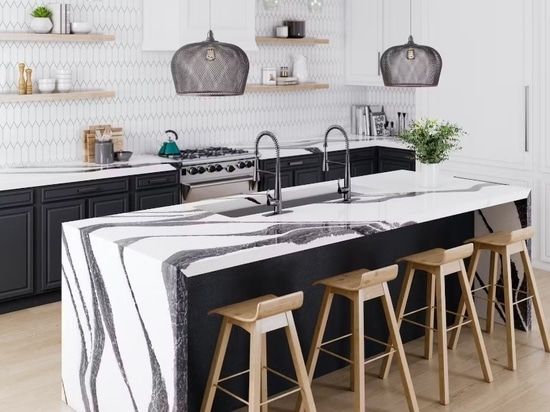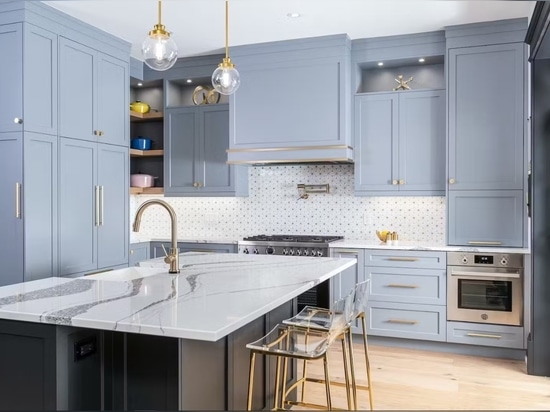
#White Papers
How to Elevate Your Countertops with Quartz (and Where to Start)
Learn why the industry is turning toward quartz surfaces and what steps to take in choosing the right design for your home should you follow suit.
Our kitchens and bathrooms are among the most used rooms in the home, and the surfaces in these rooms are some of the hardest-working—with everything from red wine spills and oil drips in the kitchen to abrasive toothpaste in the bathroom to contend with.
While materials such as marble, granite, concrete, and soapstone are undeniably beautiful, they need high levels of maintenance to keep them looking their best. Marble—for example—is soft and porous, which means it needs sealing annually and has the potential to stain and scratch over time. So, it’s important to consider a natural material that will endure for decades (especially when the general rule is that bathrooms and kitchens should be redone every 10 to 15 years).
"Quartz, like granite or marble, is a natural stone. It’s nonabsorbent, highly durable, and maintenance free—making it an everlasting surface," says Summer Kath, Executive Vice President of Design at Cambria. "As such, quartz surfaces are the best countertops on the market today. They are best in performance and the beauty and variety of designs to choose from are endless."
Quartz, and Cambria in particular, has become a popular choice for architects, interior designers, and homeowners as it has the most expansive design palette on the market today, allowing clients to express themselves in any style.
It’s also incredibly durable. "Not only is quartz chip, scratch, and stain resistant, it also never needs sealing, reconditioning, or polishing," says Michael Carter, manager of the Cambria Gallery on El Paseo in Palm Desert, California. "Our clients really appreciate all these qualities when it comes to choosing their countertops."
While any renovation project is a big undertaking, the hardest part is getting started—so we asked the design experts at Cambria to walk us through the steps to consider when you’re thinking of replacing your home’s hardest-working surfaces.
Step 1: Create a Brief
It’s important to have a good idea of what you want before you start your project. While you don’t need to have a full concept visualized, ask yourself the important questions. Do you want to do a full remodel or a freshen up? What is it that you don’t like about your current kitchen or bathroom? What’s your budget and timeline? "If you’re on a budget, consider just swapping out your old countertops, sink, and tapware," recommends Kath. "It makes a big visual and functional impact while modernizing your space."
As kitchens and bathrooms typically last many years, it’s easy to become out of touch with prices for new surfaces and appliances. Do some research before taking the next steps to get a realistic understanding of the costs involved. "It’s best for everyone if you know your comfort level for your project and your expectations in advance," adds Carter.
Step 2: Dig Into Your Options
Once you have a good idea of what you want, it’s time to start the exciting part of the process: discovery. "Quartz allows a client to express their own personality," says Carter. "With the correct lighting, quartz shines like no other material in a room giving it a luxurious and modern feel." Pinterest, Instagram, and design websites are good places to look for inspiration—and many clients begin a folder of spaces that they love and want to live with.
Company websites are a valuable resource for the early stages of a project, with plenty of images showcasing colors and completed projects. "We always ask the homeowner to look at our website ahead of their visit to familiarize themselves with our designs," says Carter. "We even encourage them to make a list of designs they like."
Step 3: Schedule a Consultation
A consultation can be either in person or online, making it easy to access from wherever you are. In person, you’ll be taken on a tour of the gallery’s sample wall where you can point out what you like and don’t like. The consultant will then help you choose designs that work with any other samples you bring along and create an overall vision for the space. "It’s very helpful if you have color samples of any cabinets or flooring that you are considering or have already ordered," says Carter. This will help consultants advise you on products that will work best in the space.
An online consultation works in a similar way to an in-person visit to the showroom and is conducted via a method that the client is comfortable with. "Some like to FaceTime and others prefer to send emails back and forth or discuss everything over the phone," says Carter.
Step 4: Pick Your Palette
After the consultation, take home samples of the designs you’re interested in. Samples are important to have with you while making other decisions about cabinets, hardware, appliances, and wall colors. "We ask that clients place the samples on the existing counters so they can envision their selection in their living spaces," says Carter. "It’s important to look at the samples at different times of the day and evening as lighting in your home will change throughout the day and designs can take on different appearances."
Step 5: Bring the Vision to Life
Once you have chosen your Cambria designs, it’s time to begin the build. "We give our clients as much guidance as possible and will refer them to our approved partners in their area," says Carter.
Planning your next countertop project? Find inspiration and order samples at CambriaUSA.com.





